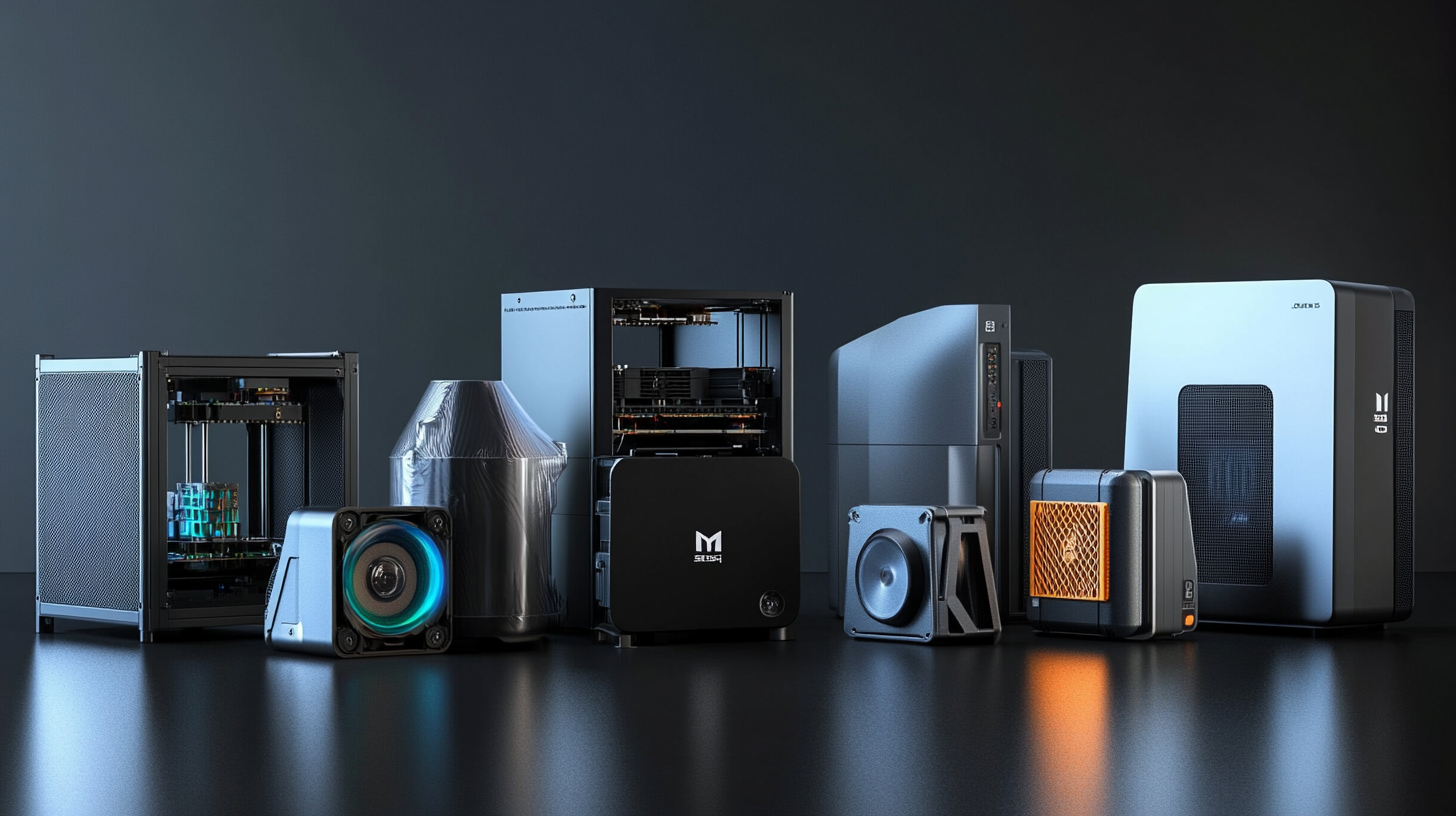2023 Essential Import & Export Certifications for Beginner 3D Printers: Top 5 Insights
The rapid advancement of 3D printing technology has transformed the landscape of manufacturing, making it accessible to a wider audience, including those new to the field. As reported by the International Data Corporation (IDC), the global 3D printing market is projected to reach $35.4 billion by 2024, with a significant portion attributed to small enterprises and hobbyists utilizing beginner 3D printers. This surge highlights the need for individuals and businesses to understand the intricacies of import and export certifications, which can play a crucial role in navigating the complex regulations that accompany international trade.
For beginners venturing into the 3D printing realm, having the right certifications not only ensures compliance but also enhances credibility and marketability. According to the 3D Printing Industry's annual report, the demand for certified 3D printed products has grown by over 40% in the last three years. As more novice operators enter the space, it's essential to equip themselves with the necessary knowledge about certifications that not only facilitate the smooth import and export of materials and products but also protect their investments. This blog will delve into the top five insights regarding essential certifications that every beginner 3D printer needs to consider to thrive in this exciting industry.

Key Certifications Every Beginner 3D Printer Should Know
When venturing into the world of 3D printing, understanding the essential certifications is crucial for beginners. These certifications not only enhance the credibility of your products but also ensure compliance with safety and quality standards. Here are some key certifications every beginner 3D printer should familiarize themselves with.
One of the primary certifications to consider is the ISO 9001, which focuses on quality management systems. Achieving ISO 9001 certification demonstrates a commitment to consistent quality, which is vital for building trust with customers. For those aiming to export their 3D printed items, the CE marking is also essential. It indicates that the products meet European health, safety, and environmental protection standards, making it a vital asset for entering the European market.
Another important certification is the UL Mark, which signifies that a product has been tested for safety by Underwriters Laboratories. This certification is particularly important for 3D printers that involve electrical components, as it reassures users that the equipment is safe to operate. Lastly, as the demand for environmentally friendly products grows, obtaining certifications related to sustainability, such as the FSC or SCS, can add significant market value. Understanding these certifications can empower beginners to navigate their 3D printing journey more effectively.
Understanding the Importance of Compliance in 3D Printing
In the rapidly evolving world of 3D printing, compliance with import and export certifications is not just an obligation; it is a critical factor that can determine the success or failure of a business. For beginners venturing into this innovative field, understanding the intricacies of various certifications is essential. Compliance ensures that products are manufactured, transported, and marketed according to established safety and quality standards, mitigating the risks associated with regulatory violations.
The significance of these certifications goes beyond mere legality; they also enhance customer trust. When consumers know that a company adheres to industry regulations, they are more likely to invest in the products being offered. This is especially important in the realm of 3D printing, where technology is often perceived as complex and potentially hazardous. By prioritizing compliance, businesses can not only safeguard their operations but also cultivate a credible brand image.
Furthermore, navigating the complexities of international trade requires familiarity with specific regulations that vary from one country to another. Beginners in 3D printing must educate themselves on the essential import and export certifications pertinent to their operations. This knowledge is pivotal in opening up new markets and ensuring the seamless movement of goods across borders. Ultimately, embracing compliance within the 3D printing sector lays the groundwork for sustainable growth and innovation.
Navigating the Certification Process: A Step-by-Step Guide
Navigating the certification process for importing and exporting 3D printers can seem daunting, especially for beginners. However, understanding the steps involved is crucial for smooth compliance and market entry. According to a recent report from the International Trade Administration, the global 3D printing market is projected to reach $34.8 billion by 2024, making effective certifications more important than ever for businesses looking to capitalize on this growth.
The first step in the certification process is identifying the relevant standards that apply to 3D printers in your target markets. For instance, many countries require compliance with safety and emissions standards such as CE marking in Europe and FCC certification in the United States. It's essential to stay informed about the region-specific regulations, as failing to meet these can result in delays or costly fines. A study published by the 3D Manufacturing Association highlights that manufacturers who have proactively engaged in certification processes have seen a 25% reduction in entry barriers within foreign markets.
Once you have identified the necessary standards, the next step is to gather the required documentation and prepare for testing. This often includes technical specifications, design details, and information on materials used in the printers. Engaging with a certification body early in the process can provide critical insights and help streamline the paperwork involved. According to a recent market report, companies that utilize consulting services in their certification journey report a 40% faster approval process, enabling quicker time-to-market and increased competitiveness in the rapidly evolving 3D printing landscape.
Following these steps diligently can lead to successful certification of 3D printers, allowing businesses to navigate the complexities of international trade effectively.

Top 5 Essential Certifications for Importing and Exporting in 3D Printing
When diving into the world of 3D printing, one crucial aspect that beginners often overlook is the importance of proper certifications for importing and exporting. These certifications not only ensure compliance with international laws but also enhance credibility in the marketplace. For those new to the industry, understanding the essential certifications can pave the way for smoother operations and successful business ventures.
First and foremost, CE marking is a vital certification for any 3D printing equipment or materials sold in Europe. This mark signifies that the products meet safety, health, and environmental protection standards. Similarly, the FCC certification is essential for 3D printers entering the U.S. market, as it regulates electromagnetic interference and ensures that devices operate without disrupting other electronic devices. Acquiring these certifications can greatly expand market reach while fostering customer trust.
Another important certification is ISO 9001, which focuses on quality management systems. Obtaining ISO 9001 certification demonstrates a commitment to quality, a major selling point in the competitive 3D printing landscape. Additionally, RoHS compliance ensures that electronic products do not contain hazardous substances, making it a critical certification for sustainability-focused companies. Together, these certifications not only fulfill regulatory requirements but also build a solid foundation for successful international trade in 3D printing.

Common Challenges and Solutions in Obtaining 3D Printing Certifications
Obtaining certifications for 3D printing can be a daunting task for beginners in the import and export sector. One of the most common challenges faced is navigating the complex regulatory landscape. Different countries have varying requirements, which can lead to confusion and delays in the certification process. It’s crucial for new entrants to thoroughly research the specific standards that apply to their products in their target markets. Leveraging resources such as government websites and trade organizations can provide clarity and ensure compliance.
Another significant hurdle is the technical knowledge required to meet certification standards. Many beginners may lack the expertise in material properties or design specifications that are crucial for passing audits and evaluations. Engaging with experienced professionals or consultants in the field can bridge this gap, offering insights on best practices and industry standards. Additionally, investing time in training workshops or online courses can enhance one's understanding of the necessary technical requirements.
Finally, maintaining documentation and demonstrating quality control can pose a significant challenge. Certifications often require comprehensive records that detail every aspect of the manufacturing process, from sourcing materials to final production. Implementing a robust quality management system is essential not only for certification purposes but also for building trust with potential partners and customers. This system can facilitate smoother verification processes and ultimately enhance business credibility in the competitive 3D printing market.